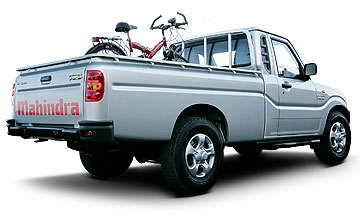BY PHILIP LORD | 16th Apr 2008

Suddenly, ute buyers want a car, weekend toy and workhorse rolled into one - and they're happy to pay for it.
Yet there are also plenty of buyers who still want a no-frills ute built to work first and foremost. The fact that Nissan brought back the old, superseded D22 Navara this year after bidding farewell to the model last year shows that there is plenty of life left for old warhorses - not everyone wants the shiniest pair of leather-soled shoes in the cupboard.
Sensible rubber-soled boots are still the requirement of many, and it is exactly this market that newcomer Mahindra hopes to exploit with its Pik-Up range.
Mahindra is not a complete stranger to the Australian market - it briefly sold a rudimentary, WWII Jeep-style 4WD in the early 1990s called the Stockman that was too little, too late for the fast-developing 4WD market.
This time, with Mahindra’s return to this market in 2007, prospects appear far more hopeful for the Indian company, with local distributor TMI Pacific investing large sums to ensure that the Mahindra brand succeeds.
While the new breed of utes are actually designed to look stylish, the Mahindra at best could be said to look fit for its intended purpose.
The upright, boxy design is not exactly the leading light for 2008’s global automotive design trends, although it might have been in 1988. Or maybe 1978.
The Pik-Up’s driving position is very much upright in the old commanding style of traditional 4WDs, and the seats themselves are average in comfort and support.
The controls are very simple, if a little cheap in their feel and operation. Fit and finish is more workmanlike than polished, with a noticeable lower level of trim quality than the competition, and the interior shakes and rattles more that the competition when driving on a rough dirt road.
Body rigidity does not appear to be quite up there with the market leaders.
The one advantage of designing the Pik-Up to look like a big rectangular box becomes obvious on the inside - there is loads of headroom and legroom, front and rear. Three adults can across the rear bench, albeit not with a great deal of shoulder space.
The tray is a relatively generous size and the Pik-Up is rated to carry a one-tonne payload. The tray has lashing points and a solid drop-down tray and rear bumperettes. While the dual-cab’s tray length and width is within close range of competitors, the 550mm tray depth is ahead of the pack.
The turbo-diesel engine’s 79kW/247Nm outputs are well behind the best in class - and with a kerb weight of 2150kg for the dual-cab 4WD the Mahindra is one of the heaviest one-tonne capacity utes, too.
Understandably, the Pik-Up is not nearly as responsive as competitors, and the truth is the engine is not especially quiet or smooth, either. Having said that, the engine is very tractable.
The gearbox shifts well enough when taking a leisurely approach to selecting gears, but can get tangled up, particularly in the second-to-third gearshift if you’re not deliberate about it.
The Mahindra’s handling and dynamics are, understandably, not up there with a sportscar - or even a family sedan, for that matter.
However, there is still a handling hierarchy among one-tonne utes and in direct comparison with its competition the Pik-Up sits towards the bottom of the pile, with more bodyroll and more determined understeer than anything bar a LandCruiser 70 series ute.
Luckily, given the load-carrying role it performs, this is not hugely relevant anyway, and there are certainly no nasty surprises in the way the Mahindra steers and corners.
Steering is light and while it feels more remote and vague on-centre than the competitors, it is easy to point the Pik-Up where you want it to go - even despite the large turning circle of 12.6 metres.
The brakes lack a progressive feel but pull-up strongly. The suspension feels rough-riding over bigger bumps when unladen, but like all such utes designed for load carrying, the ride quality smoothes out with more weight on board.
While the Pik-Up may not shine on the road, it positively radiates when travelling off-road. While it is not perfect, it does have the best over-bonnet visibility of its class and the compact body and strong limited-slip rear diff will make up for a lack of wheel travel.
The plentiful ground clearance, excellent low-range reduction gearing, engine braking and approach, ramp-over and departure angles also contribute to making the Pik-Up a compelling case off-road.
The Pik-Up comes in one trim and engine specification, with the option of single or dual-cab as a 2WD or a 4WD, and has a three-year/100,000km warranty (plus one-year breakdown assist).
The standard equipment list is quite generous, given the price range of $23,990 (single-cab 2WD) to $29,990 (dual-cab 4WD).
The Pik-Up has air-conditioning, a radio/CD/MP3/SD card compatible sound system, remote central locking, alarm and engine immobiliser, power windows, front fog lights and follow-me-home headlights, tonneau cover and steel side steps.
The omissions are cruise control (TMI Pacific says it will introduce this next year), ABS brakes and airbags (which are due later this year).
There is something quite appealing about a vehicle that has no allusions to greatness one that simply promises to serve as a faithful workhorse all the while offering great value.
The Mahindra is very appealing for all these reasons: tough, simple, roomy and with all the essential features owners want. But like buying the discount tools at the hardware shop, you can’t expect to get the sharpest quality tool in the shed.
Provided that you are willing to accept that, and in particular accept that safety equipment is not yet on par with other utes, then the Pik-Up is a welcome, no-nonsense alternative to the Japanese mainstream.